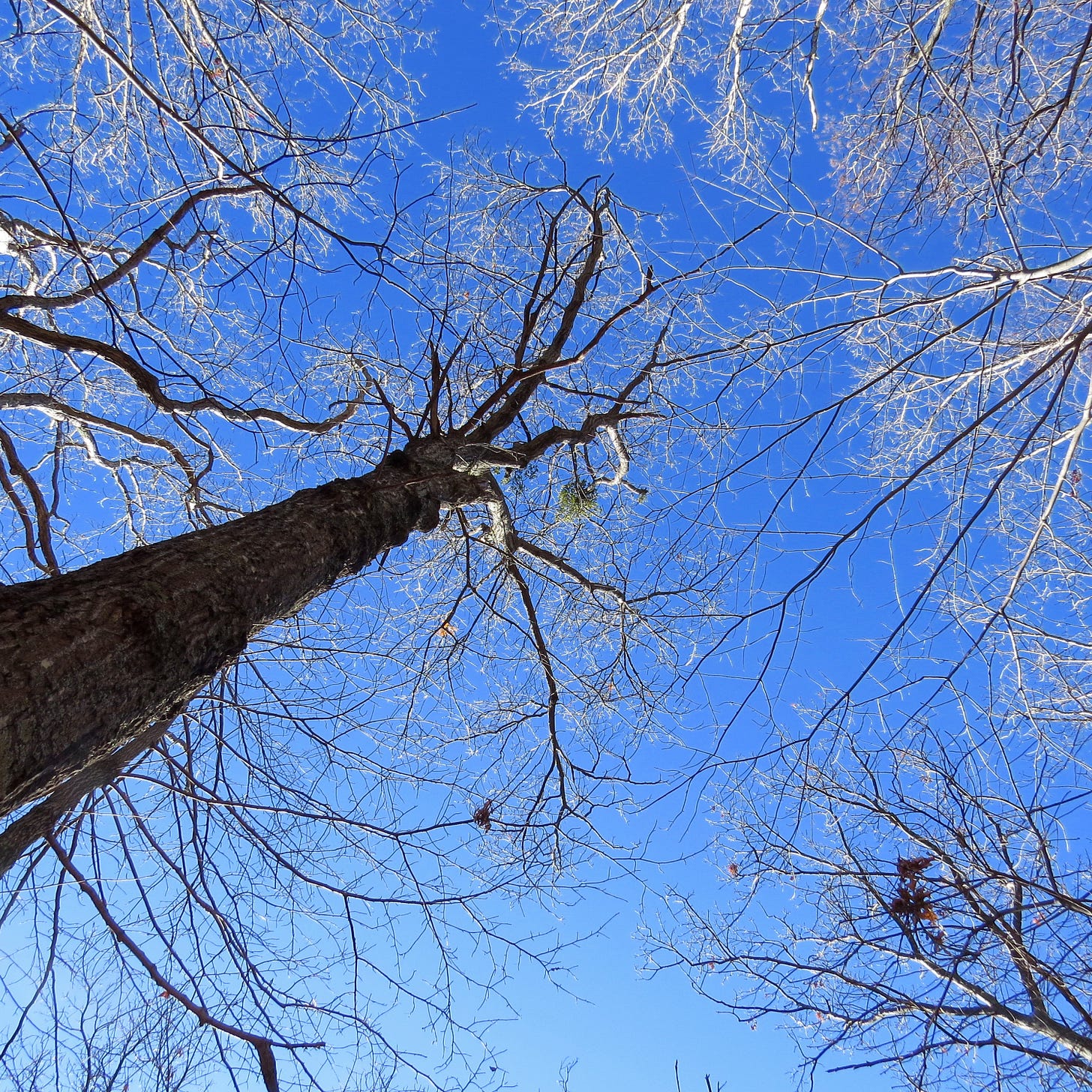Celtic Druids thought mistletoe represented the oak tree's heart or soul and Greeks considered it a symbol of sexuality and fertility. Thinking it would be nice hang in my big old house during Christmas, I went out to buy some. I soon discovered, however, when you live in the southern Appalachian Mountains, you don't buy mistletoe in a store. You search for it in the woods then blast it out of the treetops with a shotgun.
"Seriously?!" I asked my Appalachian-born boyfriend, Tom, when he told me this.
"Yes," he said, seriously. "It's called harvesting."
Mistletoe is a lazy and opportunistic plant, most often found in the top branches of apple and oak trees. While it’s capable of creating its own food through photosynthesis, it prefers to wriggle its roots down into the bark of a host tree and freeload nutrients, often harming or killing the tree in the process. Once I learned this, I didn't feel so badly to hear that it sometimes gets shot out of the sky.
"Oh, please take me with you to find some!" I begged him.
This is exactly the kind of Appalachian adventure I was looking to capture in photographs, so the hunt for mistletoe was on.
By now I had lived in these mountains long enough to know that life in Appalachia can be a tease – any time you assume you are in control of your own adventures, you may quickly find out how very wrong you can be.
Tom began looking for mistletoe each day as he drove around for work. On the weekends, he told me he scanned the trees in the mountains surrounding his parents' farm. But no mistletoe; the upper branches held nothing but the occasional squirrel's nest.
A few days before Christmas that year, I decided to drive out into the mountains myself. Asheville is a popular tourist town, but it is surrounded by bucolic areas, and it takes only a few moments to find yourself in a completely different world. I ended up driving somewhat aimlessly around in a 66.8 square miles area once known as Turkey Creek. It’s said that in 1859, a frontiersman by the name of Leicester Chapman renamed the area Leicester for the Earl of Leicester. Most likely, he named it after himself.
While no longer a frontier, it’s still a very rural area. A world where road signs are pulled down at night to confuse outsiders looking to buy land cheap. A world where you still see skinny metal mailboxes in a row alongside the road, their little red flags hanging down listlessly, their doors hanging open like baby birds waiting to be fed. A world where everyone knows everyone else’s kin, but not you or yours. A world where you might have to be a little careful if you are an outsider who happens to wander onto someone's property.
Tom had cautioned me about driving around by myself out in the mountains and hollers, but I was determined to find some mistletoe.
I was about thirty minutes away from the relative safety of town when, just as I was rounding a curve on a rural country road, I spotted a bundle of green hanging on a nearby porch. Was it mistletoe, I wondered? I pulled my car over to the side of the road and got out to take a closer look.
Camera in hand, I was walking around the edges of what looked to be someone’s front yard when I heard a door open, then a gruff voice say grudgingly, almost menacingly, "Can I help you?"
I froze, then slowly turned around.
The man attached to the voice was perhaps in his early 70s. His piercing grey eyes looked at me from underneath a worn cap, sizing me up.
In a heartbeat, scenes from Stranger with a Camera – a documentary film by Elizabeth Barrett about the 1967 killing of filmmaker Hugh O’Connor flashed through my mind.
Being a documentary, it was, of course, a true story. O’Connor, a Scottish Canadian filmmaker, had been hired to direct a film about President Johnson’s War on Poverty, which was largely focused on Letcher County in the eastern Kentucky region, which with its poor coal-mining areas had become a metaphor for parts of the US the “American Dream” had never reached.
Reporters, journalists, and film crews had been coming to this impoverished region of Appalachia for years, which made some residents hopeful for change. But others felt exploited and embarrassed by the media’s spotlight on them which had yet to result in any improvement or change to their circumstances.
On the last day in the area, O’Connor was filming a conversation with a weary miner sitting on the front porch of a shack he rented from Hobart Ison, the Appalachian version of a slum lord. Word of the outsider film crew had quickly made it around town. When the news reached Hobart Ison, he grabbed his Smith & Wesson and, as the story goes, drove over to their location where he shot the crew, killing O’Connor.
I’d first heard about the film at the Grove Park Inn in Asheville. My mother and I were having a glass of wine near the roaring fireplace at a table we shared with an older gentleman from Kentucky and his wife. When he heard I worked with documentary films, he told me the story of Stranger with a Camera. As strange circumstance would have it, he’d been part of the legal team defending Ison – and in so doing, at least in their own minds, defending a way of life in Eastern Kentucky.
Ison was convicted of involuntary manslaughter.
“Did he go to jail?” I’d asked the lawyer.
“For about a minute!” he laughed. “Ison served just one year of his ten-year sentence. That’s just how things worked around there.”
And now here I was, trespassing on this man’s property, also a stranger with a camera, and in Appalachia, wondering why I hadn’t considered that documentary as possible foreshadowing, as a warning. Was I willing to risk my life for mistletoe? No. I did not want it that badly.
The old man was quiet for a moment, looking me up and down, judging me. Over on my side of the face off, I was trying, as discretely as possible, to see if he was carrying a gun.
Slowly and quietly, I introduced myself, apologizing for stepping onto his property and identifying that I lived in Asheville. When I mentioned I lived in the old Giezentanner house, I was in luck. The old man had known the Giezentanners; he’d shopped in their store, as had many, back in the day. He even knew some of them personally.
“I’m looking for mistletoe to hang in my house for Christmas,” I explained, hoping I sounded innocent and unthreatening. “Can you tell me where I might be able to find some?”
He gave me another long, hard stare.
"Charlie might have some up the road," he said, after some thought. This man’s house was at the intersection of several rural roads, so I had no idea where exactly ‘up the road’ was, much less who Charlie was.
"Up Bear Creek Road," he added helpfully.
One comment slowly led to another, and we got to talking. He invited me to come inside the large cinderblock garage next to his old house so we could sit down and have a proper talk. Heart in my mouth but uncertain how to make a graceful exit, I followed him inside.
It was his tire business and there were tires piled up in stacks everywhere. He looked around, then gestured for me to sit on a stool at the service counter while he did the same. Soon, he was telling me stories about Asheville in the old days. He told me about his grown son and two daughters, which ones were a disappointment and which one he was proud of. Gradually, I realized he just wanted someone to talk to. After an hour or so, the stories began tapering to an end, and I got up to leave.
"About that mistletoe," he said, remembering. "Take a left up Bear Creek and look for the end of the fence. See if there's any up around there."
I nodded, thanked him and with incredible relief, got back into my car. I found Bear Creek Road and I found many fences. I didn't, however, find any mistletoe.
Even though it turned out fine in the end, after this run-in I gave up my search and the adventure of seeing it being "harvested.”
The day after Christmas, Tom and I decided to work off our holiday excesses by hiking the Kitsuma Peak Trail in Pisgah National Forest with a group of friends. About an hour into our climb, he turned around.
"Look up!" he said with a smile.
I looked skyward. And there, high up in the trees, was a lovely lacing of green leaves.
Mistletoe.
Kristin Fellows is a published writer, world traveler, and a well-seasoned documentary film consultant. When not writing, Kristin can often be found listening to someone’s story or behind the lens of one of her cameras.
More about Kristin @ kristinfellowswriter.com
[Top photo of me by Ken Lane; bottom photo by Tom Hunnicutt]






I didn’t know that Mistletoe is a parasitic plant. I always thought it was a fungus. Not the same things. Being a curious creature. I learn something new every day.